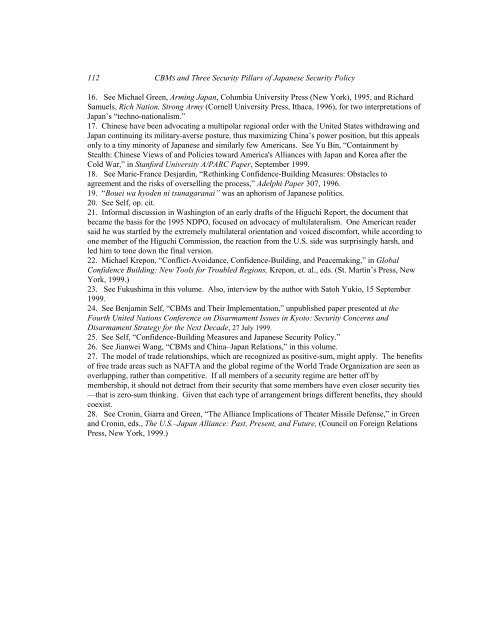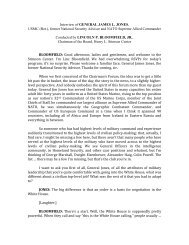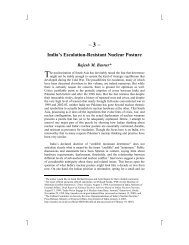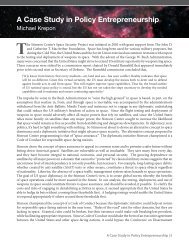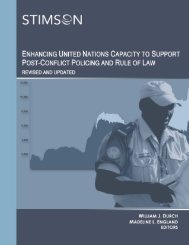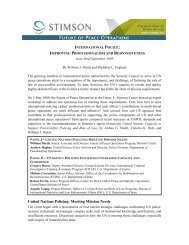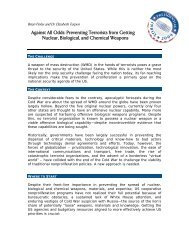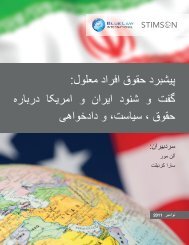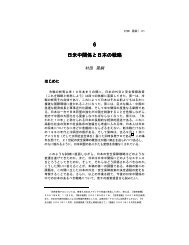CBMs and the Three Pillars of Japanese Security Policy, by ...
CBMs and the Three Pillars of Japanese Security Policy, by ...
CBMs and the Three Pillars of Japanese Security Policy, by ...
You also want an ePaper? Increase the reach of your titles
YUMPU automatically turns print PDFs into web optimized ePapers that Google loves.
112<br />
CBMS <strong>and</strong> <strong>Three</strong> <strong>Security</strong> <strong>Pillars</strong> <strong>of</strong> <strong>Japanese</strong> <strong>Security</strong> <strong>Policy</strong><br />
16. See Michael Green, Arming Japan, Columbia University Press (New York), 1995, <strong>and</strong> Richard<br />
Samuels, Rich Nation, Strong Army (Cornell University Press, Ithaca, 1996), for two interpretations <strong>of</strong><br />
Japan’s “techno-nationalism.”<br />
17. Chinese have been advocating a multipolar regional order with <strong>the</strong> United States withdrawing <strong>and</strong><br />
Japan continuing its military-averse posture, thus maximizing China’s power position, but this appeals<br />
only to a tiny minority <strong>of</strong> <strong>Japanese</strong> <strong>and</strong> similarly few Americans. See Yu Bin, “Containment <strong>by</strong><br />
Stealth: Chinese Views <strong>of</strong> <strong>and</strong> Policies toward America's Alliances with Japan <strong>and</strong> Korea after <strong>the</strong><br />
Cold War,” in Stanford University A/PARC Paper, September 1999.<br />
18. See Marie-France Desjardin, “Rethinking Confidence-Building Measures: Obstacles to<br />
agreement <strong>and</strong> <strong>the</strong> risks <strong>of</strong> overselling <strong>the</strong> process,” Adelphi Paper 307, 1996.<br />
19. “Bouei wa hyoden ni tsunagaranai” was an aphorism <strong>of</strong> <strong>Japanese</strong> politics.<br />
20. See Self, op. cit.<br />
21. Informal discussion in Washington <strong>of</strong> an early drafts <strong>of</strong> <strong>the</strong> Higuchi Report, <strong>the</strong> document that<br />
became <strong>the</strong> basis for <strong>the</strong> 1995 NDPO, focused on advocacy <strong>of</strong> multilateralism. One American reader<br />
said he was startled <strong>by</strong> <strong>the</strong> extremely multilateral orientation <strong>and</strong> voiced discomfort, while according to<br />
one member <strong>of</strong> <strong>the</strong> Higuchi Commission, <strong>the</strong> reaction from <strong>the</strong> U.S. side was surprisingly harsh, <strong>and</strong><br />
led him to tone down <strong>the</strong> final version.<br />
22. Michael Krepon, “Conflict-Avoidance, Confidence-Building, <strong>and</strong> Peacemaking,” in Global<br />
Confidence Building: New Tools for Troubled Regions, Krepon, et. al., eds. (St. Martin’s Press, New<br />
York, 1999.)<br />
23. See Fukushima in this volume. Also, interview <strong>by</strong> <strong>the</strong> author with Satoh Yukio, 15 September<br />
1999.<br />
24. See Benjamin Self, “CBMS <strong>and</strong> Their Implementation,” unpublished paper presented at <strong>the</strong><br />
Fourth United Nations Conference on Disarmament Issues in Kyoto: <strong>Security</strong> Concerns <strong>and</strong><br />
Disarmament Strategy for <strong>the</strong> Next Decade, 27 July 1999.<br />
25. See Self, “Confidence-Building Measures <strong>and</strong> <strong>Japanese</strong> <strong>Security</strong> <strong>Policy</strong>.”<br />
26. See Jianwei Wang, “CBMS <strong>and</strong> China–Japan Relations,” in this volume.<br />
27. The model <strong>of</strong> trade relationships, which are recognized as positive-sum, might apply. The benefits<br />
<strong>of</strong> free trade areas such as NAFTA <strong>and</strong> <strong>the</strong> global regime <strong>of</strong> <strong>the</strong> World Trade Organization are seen as<br />
overlapping, ra<strong>the</strong>r than competitive. If all members <strong>of</strong> a security regime are better <strong>of</strong>f <strong>by</strong><br />
membership, it should not detract from <strong>the</strong>ir security that some members have even closer security ties<br />
—that is zero-sum thinking. Given that each type <strong>of</strong> arrangement brings different benefits, <strong>the</strong>y should<br />
coexist.<br />
28. See Cronin, Giarra <strong>and</strong> Green, “The Alliance Implications <strong>of</strong> Theater Missile Defense,” in Green<br />
<strong>and</strong> Cronin, eds., The U.S.–Japan Alliance: Past, Present, <strong>and</strong> Future, (Council on Foreign Relations<br />
Press, New York, 1999.)


